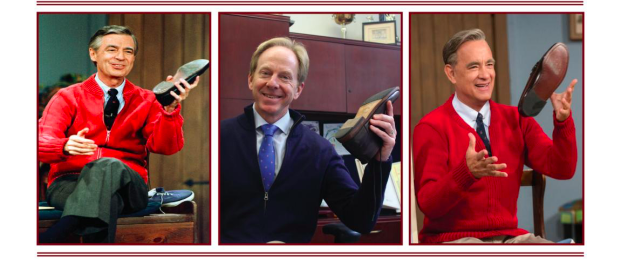Our Very Own Mister Rogers
April 11, 2020
Mister Rogers is a name everyone knows. Our generation never actually watched his show, but we know of his show. He had a puppet and a song, and walked around a neighborhood, but that’s about the extent of our Mister Rogers knowledge. The new movie “A Beautiful Day in the Neighborhood” completely changes that.
Directed by 40-year old director Marielle Heller, the movie stars Tom Hanks, already known for his kindness, as Fred Rogers, and Matthew Rhys as Lloyd Vogel. It beautifully illustrates the story of the hard-edged investigative journalist – Lloyd Vogel – who believes everything in life has an ugly side. He is forced to write a profile on Fred Rogers, and throughout the course of his interviews and time spent with Rogers, Vogel opens up about his difficult childhood and sees the beauty of the simple things. Mister Rogers helps show Vogel the happier parts of the world, and gives him hope that not everything has to be corrupt or dark-sided.
It was based on the true story of Tom Junod’s article “Can You Say… Hero?”, published in Esquire Magazine in 1998. Junod’s name was changed to Lloyd Vogel, and there are slight differences, but overall, the movie was meant to capture his experience as he writes about, and eventually becomes friends with Fred Rogers. They remained friends until Rogers died in 2003. Junod is still alive at 61 years old, and still writes for Esquire Magazine. His work has become slightly less jaded and dark since he met Mister Rogers.
Though the movie has received excellent reviews and stars a very famous actor, the main group of people watching this movie is adults and little children, not teenagers. That can be expected considering they were the ones who watched him as a kid, but there should be less of an age gap between the audience members. Teenagers should learn more about the man who taught an entire generation about empathy and kindness. There are not too many people in the world who can teach a lesson every week in a way everyone can understand and grasp.
One way Sequoia students might think about Mister Rogers is by comparing him to our very own Mr. Gary Gooch.
“He’s working really hard so that the school is a safe place for everybody and everybody feels happy here, so I feel like that’s very Mister-Rogers-like,” sophomore Anja Linkwitz says.
Anja has never seen the movie, and knows very little about Mister Rogers, but she does know the good he has done in the world, and after learning about the movie, said she would like to see it now.
“I grew up watching Mister Rogers,” says Mr. Gooch. “He was one of my earliest childhood role models.”
Mr. Gooch was inspired by “Mister Rogers’ Neighborhood”, similar to many other children who watched the show. From it, he learned about kindness, patience, forgiveness, and strength in being who you are. Now, Mr. Gooch teaches these same lessons to Sequoia students, carrying on the Mister Rogers legacy.
There are not an abundance of people today who try to uphold the teachings of Mister Rogers, or even remember all of his lessons. But with teachers who watched him and movies that document his life, the new generations have the chance to understand his wise words of courage and kindness he taught our parents.
During this time of stress in both politics and daily life, ease your mind for a couple hours and watch “A Beautiful Day in the Neighborhood” with your parents or family, and either learn or remember the wonderful lessons we get from Mister Rogers.

Left: the original Mister Rogers on “Mister Rogers’ Neighborhood”
Right: Tom Hanks as Mister Rogers in “A Beautiful Day in the Neighborhood”
Middle: AVP Gary Gooch posing as Mister Rogers, complete with tie and sweater






